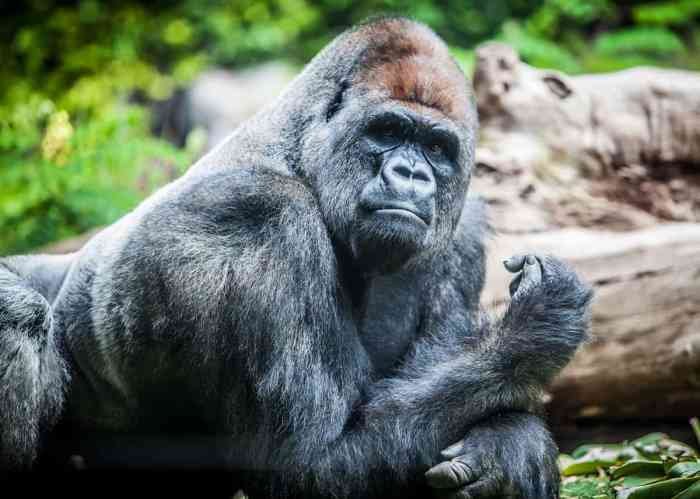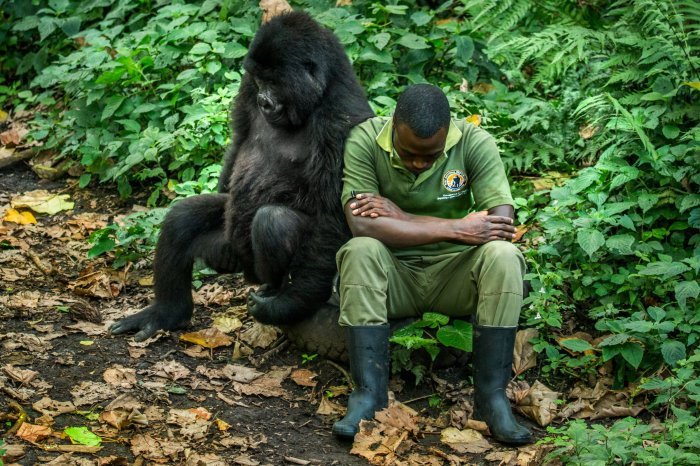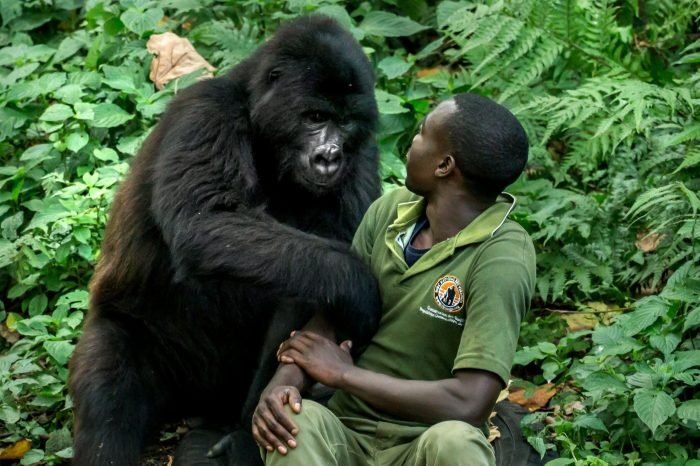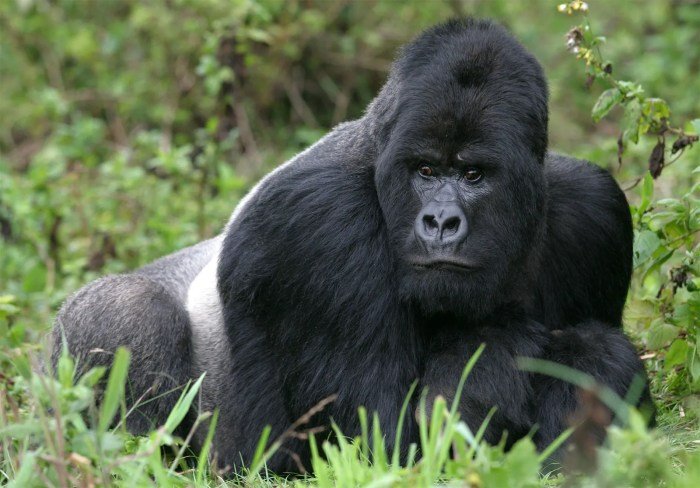Gorilla health, a critical component of ensuring the survival of these magnificent primates, is a complex and multifaceted issue. These gentle giants face numerous threats, ranging from habitat loss and poaching to the spread of diseases. Understanding the factors that contribute to gorilla health, including their diet, social interactions, and the impact of human activities, is crucial for developing effective conservation strategies.
The health of gorillas is directly linked to the health of their ecosystems. Their role as keystone species within their habitats highlights the interconnectedness of all living things. By protecting gorillas and their environments, we contribute to the overall biodiversity and well-being of our planet.
Gorilla Health

Gorilla health is a critical aspect of conservation efforts, ensuring the survival and well-being of these magnificent primates. It encompasses their physical, mental, and social well-being, encompassing factors like diet, habitat, and social interactions.
Factors Contributing to Gorilla Health
Gorilla health is influenced by a multitude of factors, each playing a vital role in their overall well-being. These factors can be broadly categorized into habitat, diet, and social interactions.
Habitat
- Forest Degradation:Deforestation and habitat loss due to human activities, such as logging, agriculture, and mining, directly impact gorilla populations. This reduces the availability of food sources and suitable living spaces, increasing vulnerability to diseases and conflicts with humans.
- Disease Transmission:The proximity of human settlements and livestock can expose gorillas to infectious diseases, such as Ebola virus disease, which can have devastating consequences for their populations. This underscores the importance of maintaining a buffer zone between human activities and gorilla habitats.
- Climate Change:Climate change impacts gorilla health through alterations in rainfall patterns, temperature fluctuations, and extreme weather events. These changes can disrupt food availability, alter disease transmission dynamics, and negatively impact overall habitat suitability.
Diet
- Dietary Diversity:Gorillas rely on a diverse diet of fruits, leaves, and stems. A lack of dietary diversity can lead to nutritional deficiencies, compromising their immune system and overall health. This is particularly concerning in areas where habitat loss has restricted their access to preferred food sources.
- Food Availability:Seasonal variations in food availability can impact gorilla health, especially during periods of scarcity. This can lead to malnutrition, reduced reproductive success, and increased vulnerability to diseases. It highlights the importance of maintaining healthy forest ecosystems that provide a consistent supply of food resources.
- Parasites and Toxins:Gorillas can be affected by parasites and toxins present in their food sources. These factors can weaken their immune system, making them more susceptible to diseases. The presence of toxins in their environment can also lead to health problems, emphasizing the need for clean and uncontaminated food sources.
Social Interactions
- Group Dynamics:Social interactions play a crucial role in gorilla health. Strong social bonds and stable group structures contribute to stress reduction, promoting overall well-being. However, disruptions in group dynamics due to human activities or disease outbreaks can negatively impact their health and survival.
- Infanticide:Infanticide, the killing of infants, can occur in gorilla groups, often associated with competition for resources or dominance hierarchies. This act can disrupt group cohesion and negatively impact the health of individuals involved. Understanding and mitigating factors contributing to infanticide is essential for gorilla conservation.
- Stress:Stress from human encroachment, habitat loss, or hunting can negatively impact gorilla health. This stress can suppress their immune system, making them more vulnerable to diseases and affecting their reproductive success. Minimizing human disturbance in gorilla habitats is crucial for their well-being.
Threats to Gorilla Health

Gorillas face numerous threats to their survival, primarily stemming from human activities. These threats have significantly impacted gorilla populations, leading to their endangerment and even extinction in some areas.
Habitat Loss and Degradation
Habitat loss is a major threat to gorillas, as it reduces their available space for foraging, nesting, and social interaction.
- Deforestation for agriculture, logging, and mining destroys gorilla habitat, forcing them into smaller and more fragmented areas.
- The expansion of human settlements and infrastructure further reduces gorilla habitat, leading to increased competition for resources.
- Climate change also contributes to habitat loss by altering rainfall patterns and increasing the frequency of extreme weather events, which can damage gorilla habitat.
The loss of habitat can lead to food scarcity, increased competition for resources, and a greater risk of disease transmission.
Poaching and Illegal Wildlife Trade
Poaching for bushmeat and the illegal wildlife trade pose significant threats to gorilla populations.
- Gorillas are hunted for their meat, which is a source of protein for local communities.
- The illegal wildlife trade, which involves the capture and sale of gorillas for pets or for use in traditional medicine, also contributes to gorilla decline.
Poaching and illegal wildlife trade can lead to a decline in gorilla populations, as they reduce their numbers and disrupt their social structures.
Disease Transmission
Gorillas are susceptible to diseases that can be transmitted from humans, livestock, and other animals.
- Human respiratory diseases, such as the common cold and influenza, can be fatal to gorillas.
- Ebola virus disease has been particularly devastating for gorilla populations, causing significant mortality rates.
Disease transmission can be exacerbated by habitat loss and human encroachment, which bring gorillas into closer contact with humans and other animals.
Human Conflict
Human conflict can also threaten gorilla populations.
- Armed conflicts can displace gorillas from their habitat and lead to increased poaching and illegal wildlife trade.
- Human-wildlife conflict can arise when gorillas raid crops or come into contact with humans, leading to retaliatory killings.
Human conflict can disrupt gorilla social structures and reduce their population size.
Conservation Efforts

Protecting gorillas requires a multifaceted approach that involves safeguarding their habitats, addressing threats, and promoting sustainable practices. Conservation efforts aim to ensure the long-term survival of these magnificent primates and their ecosystems.
Habitat Protection
Habitat protection is a cornerstone of gorilla conservation. Gorilla populations are highly dependent on intact forests, and the destruction of these habitats poses a significant threat.
The health of gorillas is a crucial aspect of their conservation, and it often relies on the expertise of dedicated professionals. For those interested in contributing to animal health, a career at careers ascension health could be a rewarding path.
These professionals play a vital role in understanding and addressing the unique challenges faced by gorillas in the wild, ensuring their continued survival and well-being.
- Protected Areas:Establishing national parks, reserves, and other protected areas provides vital sanctuaries for gorillas and helps prevent habitat loss from deforestation and other human activities.
- Community Engagement:Involving local communities in conservation efforts is crucial. This can be achieved through education, awareness programs, and sustainable livelihood initiatives, fostering a sense of ownership and responsibility for gorilla protection.
- Anti-Poaching Measures:Poaching for bushmeat and other illegal activities remains a serious threat to gorillas. Anti-poaching patrols, community-based monitoring, and law enforcement are essential to combat this problem.
Conservation Programs
Numerous organizations and governments have implemented successful conservation programs that demonstrate the effectiveness of targeted efforts.
Gorilla health is a fascinating topic, with researchers studying everything from their diet to their social interactions. Keeping fit is essential for their well-being, just as it is for humans. If you’re looking to boost your own fitness routine, check out this gym fitness t shirt for some extra motivation.
Understanding gorilla health can provide insights into how we can better care for ourselves and ensure a healthy future for these amazing creatures.
- Dian Fossey Gorilla Fund:This renowned organization has played a pivotal role in gorilla conservation for decades. Their efforts include habitat protection, anti-poaching initiatives, and research that contributes to our understanding of gorilla behavior and ecology.
- Wildlife Conservation Society:This organization works in various African countries to protect gorillas and their habitats through research, community engagement, and habitat restoration programs.
- Gorilla Rehabilitation and Release Programs:These programs aim to rescue and rehabilitate gorillas that have been orphaned, injured, or captured. Once rehabilitated, these gorillas are often released back into the wild, contributing to the overall population.
Role of Research and Monitoring
Research and monitoring are essential for understanding gorilla populations, identifying threats, and evaluating the effectiveness of conservation interventions.
- Population Monitoring:Regular surveys and monitoring programs help assess gorilla population trends, identify areas of concern, and track the impact of conservation efforts.
- Disease Surveillance:Research on diseases that affect gorillas, such as Ebola, is crucial for developing effective prevention and treatment strategies.
- Habitat Research:Studying gorilla habitat preferences and the impact of environmental changes on their survival provides valuable insights for conservation planning.
Gorilla Health Research

Gorilla health research is crucial for understanding the threats facing these magnificent primates and developing effective conservation strategies. It allows scientists to gain insights into their biology, diseases, and the impact of human activities on their well-being. This knowledge is vital for informing conservation efforts and ensuring the long-term survival of gorilla populations.
Methods Used to Study Gorilla Health
Scientists employ a range of methods to study gorilla health, with a strong emphasis on non-invasive techniques to minimize disturbance to these sensitive animals. These methods include:
- Fecal Sampling:This widely used technique involves collecting gorilla droppings to analyze their genetic makeup, hormonal levels, and presence of parasites or pathogens. It provides valuable information about their diet, reproductive status, and overall health without requiring direct contact with the animals.
- Behavioral Observations:Scientists carefully observe gorilla behavior in their natural habitat to assess their social interactions, foraging patterns, and physical condition. These observations can provide insights into their health status, stress levels, and potential threats.
- Camera Traps:These automated cameras capture images and videos of gorillas, allowing researchers to monitor their movements, population size, and habitat use without disturbing them.
- Remote Sensing:Using satellite imagery and aerial photography, researchers can analyze gorilla habitat characteristics, such as vegetation cover and forest fragmentation, to assess the impact of environmental changes on their populations.
Key Research Findings Related to Gorilla Health
Here is a table summarizing some key research findings related to gorilla health:
| Finding | Description | Impact |
|---|---|---|
| High Prevalence of Intestinal Parasites | Studies have revealed a high prevalence of intestinal parasites in gorilla populations, particularly in areas with high human population density. | Parasites can weaken gorillas, making them more susceptible to other diseases and reducing their reproductive success. |
| Emerging Infectious Diseases | Gorilla populations are increasingly exposed to emerging infectious diseases, such as Ebola virus disease, which can cause devastating outbreaks. | Outbreaks of infectious diseases can decimate gorilla populations and threaten their long-term survival. |
| Impact of Habitat Loss and Degradation | Loss and degradation of gorilla habitat due to deforestation, agriculture, and mining activities can lead to reduced food availability, increased disease transmission, and reduced population densities. | Habitat loss and degradation are major threats to gorilla survival, impacting their health and overall well-being. |
| Genetic Diversity and Inbreeding | Small and isolated gorilla populations can experience reduced genetic diversity, increasing the risk of inbreeding and genetic disorders. | Inbreeding can weaken gorilla populations, making them more susceptible to diseases and reducing their adaptability to environmental changes. |
The Future of Gorilla Health

The future of gorilla health is intertwined with the success of conservation efforts and the ability to adapt to a rapidly changing world. While significant progress has been made in understanding and protecting gorillas, ongoing challenges and emerging threats require a proactive approach to ensure their long-term survival.
Challenges and Opportunities for Gorilla Conservation
The future of gorilla conservation faces a complex web of challenges and opportunities. Understanding these factors is crucial for developing effective strategies to ensure the continued existence of these magnificent primates.
- Habitat Loss and Degradation:Deforestation, driven by agriculture, logging, and mining, continues to threaten gorilla habitats. This loss of essential resources, including food and shelter, directly impacts gorilla populations and their ability to thrive.
- Human-Wildlife Conflict:As human populations expand, the potential for conflict with gorillas increases. This conflict can lead to gorilla deaths, habitat degradation, and a decline in population numbers.
- Disease Transmission:Gorillas are susceptible to diseases, including those transmitted from humans. The emergence of new diseases, coupled with the potential for zoonotic transmission, poses a significant threat to gorilla health.
- Climate Change:Climate change is predicted to have a significant impact on gorilla habitats, altering rainfall patterns, increasing temperatures, and potentially leading to changes in vegetation. These changes could disrupt food sources and lead to habitat loss.
- Illegal Wildlife Trade:The illegal trade in bushmeat and body parts continues to threaten gorilla populations. This trade often involves poaching, which directly contributes to gorilla deaths and habitat degradation.
- Lack of Resources:Conservation efforts often face challenges due to limited resources, including funding, personnel, and equipment. These constraints can hinder the implementation of effective conservation strategies.
Despite these challenges, there are also opportunities for gorilla conservation:
- Increased Awareness:Public awareness of gorilla conservation issues is growing, leading to increased support for conservation efforts. This support can translate into financial contributions, volunteerism, and policy advocacy.
- Technological Advancements:Advancements in technology, such as remote sensing and DNA analysis, provide new tools for monitoring gorilla populations, identifying threats, and developing effective conservation strategies.
- Community Involvement:Engaging local communities in conservation efforts is essential for long-term success. This involves empowering communities to participate in conservation initiatives, promoting sustainable livelihoods, and addressing the root causes of human-wildlife conflict.
- International Cooperation:Collaboration between governments, conservation organizations, and local communities is essential for addressing the transboundary nature of gorilla conservation. This includes sharing information, coordinating efforts, and addressing the illegal wildlife trade.
The Impact of Climate Change on Gorilla Populations
Climate change poses a significant threat to gorilla populations, potentially impacting their habitats, food sources, and overall health.
Gorilla health is a fascinating area of study, with researchers constantly working to understand their complex needs. One aspect of gorilla health that’s often overlooked is their appearance, and how it relates to their overall well-being. You might be surprised to learn that there’s a whole industry dedicated to helping animals look their best, much like the beauty house industry for humans.
While gorillas don’t need facials or manicures, their health is directly tied to their appearance, which can be an indicator of their overall well-being.
- Habitat Alteration:Climate change is expected to alter rainfall patterns, leading to periods of drought or excessive rainfall. These changes can disrupt vegetation patterns, affecting gorilla food sources and leading to habitat loss.
- Disease Transmission:Climate change can create conditions that are favorable for the spread of diseases, including those that can impact gorillas. This includes changes in temperature and humidity, which can affect disease vectors and increase the risk of zoonotic transmission.
- Increased Competition:As climate change alters habitats, gorillas may face increased competition for resources from other species. This can lead to food scarcity, territorial disputes, and a decline in population numbers.
Examples of the potential impact of climate change on gorilla populations include:
- Mountain Gorillas:In the Virunga Massif, where mountain gorillas reside, climate change is expected to alter the distribution and abundance of key food plants, potentially impacting gorilla diets and survival.
- Western Lowland Gorillas:In the Congo Basin, climate change is predicted to increase the frequency and intensity of droughts, leading to habitat loss and increased vulnerability to disease.
Promoting Gorilla Health and Conservation
A comprehensive plan for promoting gorilla health and conservation must address the challenges and opportunities Artikeld above. This plan should focus on:
- Habitat Protection:Protecting and restoring gorilla habitats is crucial for their long-term survival. This includes establishing protected areas, promoting sustainable land management practices, and reducing deforestation.
- Disease Prevention and Management:Implementing measures to prevent and manage disease outbreaks is essential for gorilla health. This includes monitoring gorilla populations for disease, developing vaccination programs, and promoting hygiene practices among human communities.
- Human-Wildlife Conflict Mitigation:Reducing human-wildlife conflict is essential for protecting gorilla populations. This involves implementing strategies to minimize encounters, such as buffer zones, and addressing the root causes of conflict, such as poverty and land scarcity.
- Community Engagement:Empowering local communities to participate in conservation efforts is crucial for long-term success. This includes providing economic incentives for conservation, promoting sustainable livelihoods, and raising awareness about gorilla conservation issues.
- Research and Monitoring:Ongoing research and monitoring are essential for understanding gorilla populations, identifying threats, and developing effective conservation strategies. This includes studying gorilla behavior, ecology, and genetics, and monitoring population trends.
- International Cooperation:Collaboration between governments, conservation organizations, and local communities is essential for addressing the transboundary nature of gorilla conservation. This includes sharing information, coordinating efforts, and addressing the illegal wildlife trade.
Summary

While the challenges facing gorilla health are significant, there is hope. Through ongoing research, innovative conservation initiatives, and a global commitment to protecting these remarkable creatures, we can ensure their survival for generations to come. By understanding the threats and implementing solutions, we can create a future where gorillas continue to thrive in their natural habitats.
FAQ Overview
What are the most common diseases that affect gorillas?
Gorillas are susceptible to a variety of diseases, including respiratory infections, parasites, and even human diseases like Ebola. Conservation efforts focus on monitoring and preventing the spread of these diseases.
How can I help protect gorillas?
Supporting reputable conservation organizations, reducing your carbon footprint, and raising awareness about the importance of gorilla conservation are all ways to contribute to their protection.
What is the current population of gorillas?
Gorilla populations are estimated to be around 100,000 individuals, with significant variation across different subspecies. Conservation efforts are working to stabilize and increase these numbers.